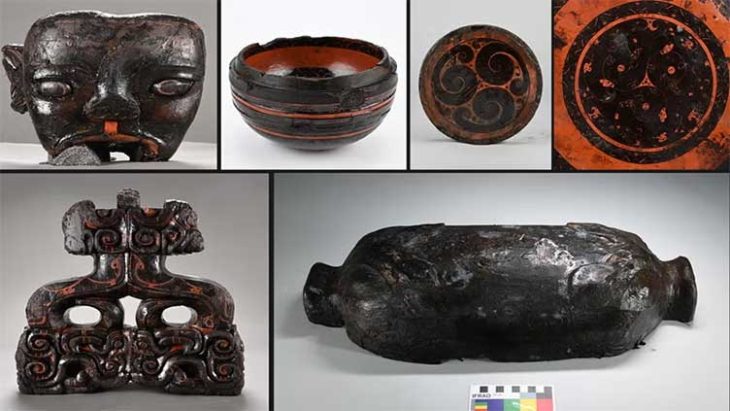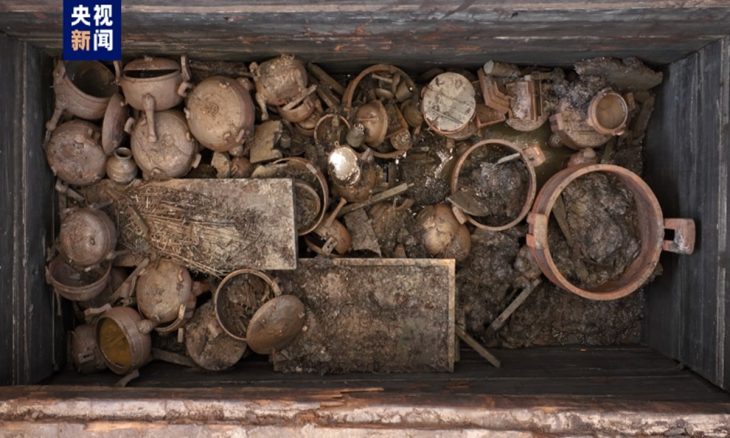Archaeologists have made a remarkable discovery in eastern China, unveiling a magnificent tomb dating back 2,200 years. Located in the Anhui Province, the Wuwangdun tomb holds immense historical significance, potentially belonging to an emperor of the Chu state, a major player during China’s Warring States period (475 BC-221 BC).
The Warring States period witnessed a tumultuous yet transformative era in Chinese history. Seven major states, including Chu, Qin, Han, Wei, Zhao, Qi, and Yan, vied for dominance. This period of conflict ultimately paved the way for the unification of China under the Qin Dynasty, marking the beginning of modern China.
The Wuwangdun tomb stands out for its sheer grandeur and complexity. It is the largest and most intricate Chu state tomb ever excavated, surpassing all previous discoveries. Archaeologists have unearthed over 1,000 artifacts from the site, including intricate figurines, musical instruments, bronze vessels, and everyday utensils. These artifacts, along with lacquerware dating to about 220 BC, offer a glimpse into the lives and culture of the Chu state during this critical period.
Prior excavations at Wuwangdun revealed a vast cemetery spanning 1.5 square kilometers. This included chariot and sacrificial pits, suggesting a prominent individual might be buried there. The newly unearthed tomb, with its scale, intricate structure, and rich contents, confirms these suspicions. Experts believe it to be the highest-ranking Chu state tomb ever discovered, potentially the final resting place of a Chu king.
Based on the tomb’s size and historical records, archaeologists speculate it might belong to King Kaolie of Chu. However, a definitive identification will require further excavation and analysis of any textual evidence found within the tomb.
The tomb has a long and tumultuous history. Evidence suggests it was looted multiple times throughout the centuries. In 2019, the Anhui Institute of Cultural Relics and Archaeology received permission to excavate and salvage the remaining artifacts. This national project underscores the importance of archaeological research in understanding the origins of Chinese civilization.
The Wuwangdun complex encompasses a vast area exceeding 140 square kilometers. It includes sacrificial pits, chariot and horse pits, accompanying graves for lesser individuals, and the main burial chamber – Tomb No. 1. This massive, nearly square pit tomb boasts sides roughly 50 meters long. A sloping passageway on the eastern side facilitates access to the tomb.
Eight side chambers surround the central pit, leading towards a central coffin chamber. Archaeologists have meticulously removed 443 coffin lid planks, revealing 78 layers of bamboo mats beneath them. Notably, these planks bear around 1,000 inscribed characters that likely detail the contents and purpose of each side chamber.

“These findings can provide a comprehensive picture of the political, economic, cultural, technological, and social landscape of the Chu state during the Warring States period,” remarked Gong Xicheng, an archaeologist involved in the excavation. He further emphasized how these discoveries contribute to our understanding of historical evolution and the formation of a unified Chinese nation and culture.
The Wuwangdun excavation provides invaluable archaeological data for studying high-level tomb systems within the Chu state during the late Warring States period. To ensure the preservation of these unearthed treasures, archaeologists have set up a special low-oxygen laboratory on-site.
The grand tomb at Wuwangdun serves as a remarkable window into a pivotal era in Chinese history. As archaeologists continue their meticulous work, we can expect further insights into the Chu state, its rulers, and the lives of its people during the Warring States period. This discovery adds a magnificent chapter to the ever-evolving story of China’s rich past.
